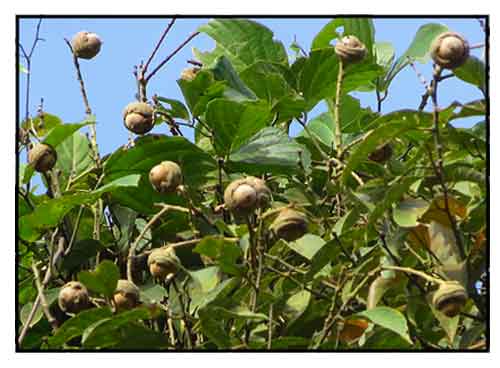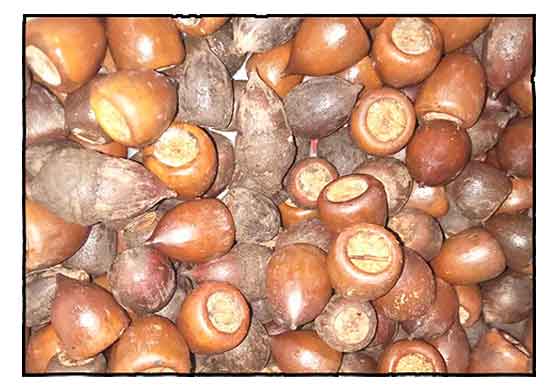 Gen info Gen info
- Fagaceae, from Latin fagus meaning "beach tree", is a family of flowering plants that includes beeches, chestnuts, and oaks, comprising eight genera with about 927 species. Fagaceae is one of the most ecologically important wood plant families in the Northern Hemisphere, as oaks form the backbone of temperate forest in North America, Europe and Asia, and one of the most significant sources of wildlife food. (2)
- Lithocarpus is a genus in the beech family, Fagaceae. Trees in the genus are commonly known as stone oaks. (4)
- Lithocarpus celebicus is a species of flowering plant in the beech family, Fagaceae. It is a predominant canopy tree in Sulawesi's mid-montane rain forests, 1500-2000 meters elevation.
It is IUCN listed as
"least concern". (5)
- Etymology: The genus name Lithocarpus derives from Greek words lithos (stone) and karpos (seed).
 Botany Botany
• Field Characters: Emergent tree (up to 40 m high), Large canopy tree, or Small sub-canopy tree (10-33 m high); Bole cylindrical (60-100 cm diam.); straight (bole up to 20 m long); buttresses buttresses present (buttresses up to 1 m high); spines spines absent; aerial roots aerial roots absent; stilt roots stilt roots absent; Bark gray or pale brown, rough, pustular, scaly or flaky, slightly fissured, or tessellated, lenticels elongated vertically; Subrhytidome (under-bark) dark red or green; less than 25 mm thick, 12.0-25.0; bark blaze consisting of one layer; faintly to non-aromatic; pleasant; outer blaze brown or red, with stripes, granular without splinters; inner blaze brown or red, with stripes, granular without splinters; bark exudate (sap) present, colorless, not readily flowing (spotty), color changing on exposure to air, to black, not sticky; terminal buds not enclosed by leaves. Indumentum: Complex hairs present, star-like (stellate) (yellowish-brown to reddish on young branchlets); stinging hairs absent; mature twig indumentum (hairs) absent. Leaves: Leaves spaced along branches, spiral (leaves occurring singly at a node and arranged spirally up the branchlet), simple (a leaf composed of a single blade); petiole present (5-10 mm long), not winged (upper surface flattened), attached to base of leaf blade, not swollen; leaves broadest at or near middle or broadest below middle, (7.0-) 12.0-16.0 (-20.0) cm, (2.5-) 4.0-6.0 (-8.0) cm; symmetric (occasionally asymmetric), entire, not dissected or lobed, acuminate (abruptly or gradually so), venation pinnate, secondary veins open, prominent (6-)8-10(-12) pairs), intramarginal veins absent; leaves lower surface pale green, yellowish brown, or slightly gray, upper surface green, slightly brown, or slightly gray, indumentum (hairs) present, indumentum (hairs) dense (minutely stellate); absent; domatia absent; stipules present, free, laterally placed, not encircling the twig, leafy (linear-acute), not fringed, large (3-4 X 0.5-1 mm), usually not persistent. Flowers: Inflorescence axillary or leaf-opposed (lateral), flowers single (female) or flowers on an unbranched axis (male in clusters of 3s; female rarely in 2s or 3s), cones absent; flowers unisexual, unisexual with male and female flowers on the same plant, not stalked, flowers slightly asymmetric, 2.0-(female flowers smallest)-4.0 mm long, diameter small (up to10 mm diam.) (2-3 mm diam.); perianth present, with all sepals and/or petals (hence tepals) similar, inner perianth pale yellow; (4-) 6 (-7), all joined; stamens (8-) 12 (-15), present, free of each other, free of the perianth; ovary inferior, carpels joined (when more than one), locules 2-6; styles free, 3. Fruits: Infrutescence arranged on unbranched axis, fruit 20.0-25.0 mm long, 20.0-22.0 mm diam., darkish brown, not spiny, non-fleshy, simple, indehiscent, nut; seeds 1, much more than 10 mm long (c. 15 mm long), not winged, broad (as wide as long), seed more than 10 mm diam. (12-15 mm diam.). (6)
Distribution
- Native to the Philippines. (1)
- Forests, from low elevation to 1200 m. Common in Mindanao, rare and scattered in Luzon, Leyte, Samar. (7)
- Of wide distribution in forests at medium altitudes from Luzon to Mindanao. In the provinces of Cagayan, Isabela, Aurora, Palawan, Zamboanga del Norte, Zamboanga del Sur, Agusan del Sur, Surigao del Sur, Davao del Norte, Davao Oriental and Lanao del Sur. (11)
- Also native to Maluku, New Guinea, Sulawesi. (1)
Constituents
- No study found.
Properties
- Studies have suggested antibacterial properties.
Parts used
Stems, roots, fruit.
Uses
Edibility
- The seeds of all Lithocarpus species are reported to be more or less edible. Most or all of them used in times of food shortage. Seed is usually cooked, but may be eaten raw. More commonly, the seed is dried, then ground into powder and used as thickening for stews or mixed with cereals for making bread. - Seeds, rich in tannins, are bitter and astringent. The tannin bitterness is removed by soaking in water, for as long and as often as needed. (10)
Folkloric
- No reported folkloric medicinal use in the Philippines.
Others
- Wood: Medium density, strong, moderately durable; suitable for general house construction, furniture and cabinetry. Also used for sliced veneer, pulpwood, and sticks. (3)
- Tannin: Tannin-rich bark used as dye or preservative for ropes. (10)
- Fuel: Wood used as fuelwood; used for making charcoal.
Studies
• Antibacterial: Study of methanol extracts of leaves, stem and root bark of Lithocarpus celebicus showed a broad spectrum of antibacterial activity, which increased on fractionation (petrol, dichloro-methane, ethyl acetate), particularly the ethyl acetate fraction of stem and petrol fraction of root bark. There was not activity against tested moulds. (8)
• Antiseptic Gel / Fruit: Study evaluated the formulation of an antiseptic gel using ethanol extract of kawang fruit in concentrations of 5%, 10%, and 20%. The 5% antiseptic gel formulation showed antibacterial activity with better inhibitory effect on Staphylococcus aureus ATCC 29213 than Escherichia coli ATCC 26922. (9)
Availability
Wild-crafted.
Seeds in the cybermarket.
|

![]()





